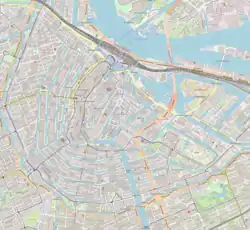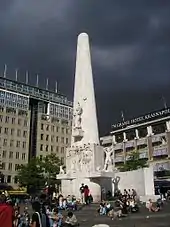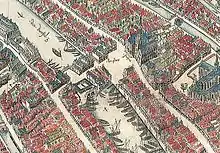Dam Square
Dam Square or Dam (Dutch pronunciation: [dɑm]) is a town square in Amsterdam, the capital of the Netherlands. Its notable buildings and frequent events make it one of the most well-known and important locations in the city and the country.
 Dam Square with the Royal Palace (center) and the Nieuwe Kerk (right) in 2005. | |
 Location in the city center of Amsterdam | |
| Native name | Dam (Dutch) |
|---|---|
| Location | Amsterdam, Netherlands |
| Postal code | 1012 JS/NP |
| Coordinates | 52.373°N 4.893°E |
| North | Nieuwendijk, Damrak, Warmoesstraat |
| East | Damstraat |
| South | Kalverstraat, Rokin, Nes (nl) |
| West | Mozes en Aäronstraat, Paleisstraat |
Location and description

Dam Square lies in the historical center of Amsterdam, approximately 750 metres (2,500 ft) south of the main transportation hub, Centraal Station, at the original location of the dam in the river Amstel. It is roughly rectangular in shape, stretching about 200 metres (650 ft) from west to east and about 100 metres (350 ft) from north to south. It links the streets Damrak and Rokin, which run along the original course of the Amstel River from Centraal Station to Muntplein (Mint Square) and the Munttoren (Mint Tower). The Dam also marks the endpoint of the other well-traveled streets Nieuwendijk, Kalverstraat and Damstraat. A short distance beyond the northeast corner lies the main Red-light district: De Wallen.
On the west end of the square is the neoclassical Royal Palace, which served as the city hall from 1655 until its conversion to a royal residence in 1808. Beside it are the 15th-century Gothic Nieuwe Kerk (New Church) and the Madame Tussauds Amsterdam Wax Museum. The National Monument, a white stone pillar designed by J.J.P. Oud and erected in 1956 to memorialize the victims of World War II, dominates the opposite side of the square. Also overlooking the plaza are the NH Grand Hotel Krasnapolsky and the upscale department store De Bijenkorf. These various attractions have turned the Dam into a tourist zone.
History

The Dam derives its name from its original function: a dam on the Amstel River, hence also the name of the city.[1] Built in approximately 1270, the dam formed the first connection between the settlements on the sides of the river.
As the dam was gradually built up to it became wide enough for a town square, which remained the core of the town developing around it. Dam Square as it exists today grew out of what was originally two squares: the actual dam, called Middeldam; and Plaetse, an adjacent plaza to the west. A large fish market arose where ships moored at the dam to load and unload goods. The area became a centre not only of commercial activity but also of the government, as the site of Amsterdam's town hall.
As a market square, the Dam had a weigh house that can be seen in some old paintings. It was demolished in 1808 by order of Louis Bonaparte who, upon taking up residence in the newly converted Royal Palace, complained that his view was obstructed.
The Damrak, or the former mouth of the Amstel River, was partially filled in the 19th century; since then, the Dam square has been surrounded by land on all sides. The new land made room for the Beurs van Zocher, a stock exchange that was built in 1837. After the stock trade moved to the Beurs van Berlage in 1903, the Zocher building was demolished. In its place, De Bijenkorf department store has stood since 1914.
In 1856, a war memorial named De Eendracht (The Unity) was unveiled inside the square before King William III. A stone column with a female statue on top, the monument acquired the nickname "Naatje of the Dam". It was taken down in 1914.
Dam Square shooting, 1945

During World War II, the Netherlands were occupied by Nazi Germany. On 7 May 1945, two days after German capitulation, thousands of Dutch people were waiting for Canadian troops to arrive on the Dam square in Amsterdam. In the Grote Club, on the corner of Kalverstraat and Paleisstraat, members of the German Kriegsmarine watched as the crowd below their balcony grew and people danced and cheered. The Germans then placed a machine gun on the balcony and started shooting into the crowds. The motives behind the shooting have remained unclear; the Germans were drunk and possibly angered because contrary to previous agreement Dutch police had arrested members of the German military.[2]
The shooting finally came to an end after a member of the Dutch resistance climbed into the tower of the royal palace and started shooting onto the balcony and into the club. At that moment, a German officer together with a Resistance commander found their way into the club and convinced the men to surrender. At the brink of peace, 120 people were badly injured and 22 pronounced dead. In 2013, evidence was brought to light that suggested the number may have been higher: possibly 33 people died, and there were 10 more unconfirmed possible victims.[3][4]
Coronation riots, 1980

The Dam Square was the central scene of the largest civil disturbance in the Netherlands post-war during the Amsterdam coronation riots on 30 April 1980.
Present

Several tram lines traverse the Dam and have stops there. In the time of the horse tram (end 19th century) the Dam was the most important tram hub of Amsterdam. After 1900 this function moved to the Central Station, at the other end of the Damrak.
Over the course of the 19th and 20th centuries, Amsterdam's main square became a "national" square well known to nearly everyone in the Netherlands. It has frequently been the location of demonstrations and events of all kinds, and a meeting place for many people. On 4 May every year, the Dutch celebrate National Memorial Day (Nationale Dodenherdenking), in observance of which the last addition to the square, the National Monument,[1] was set up in 1956.
A funfair was held on Dam Square for several years.
On December 6, 2003 Bulgarian mobster Konstantin "Samokovetsa" Dimitrov was shot dead on Dam Square.

References
- Martin Dunford (2010). The Rough Guide to The Netherlands. Penguin. pp. 62–63. ISBN 978-1-84836-882-8.
- "Doden op 7 mei 1945". Amsterdam City Archives. Archived from the original on 1 October 2011. Retrieved 7 May 2013.
- "'Op 7 mei '45 meer mensen doodgeschoten op Dam dan gedacht'". de Volkskrant. 7 May 2013. Retrieved 7 May 2013.
- List of the victims of the shooting
External links
| Wikimedia Commons has media related to Dam Square. |
